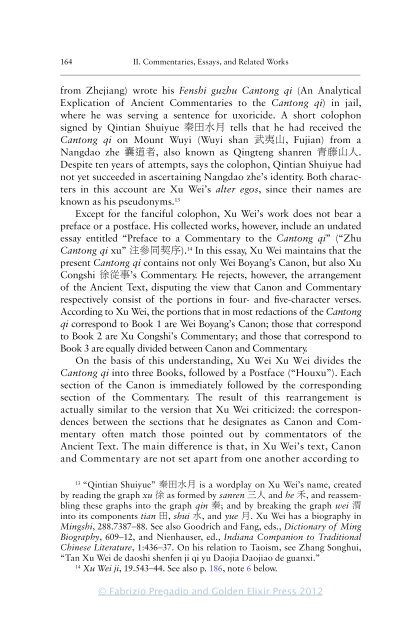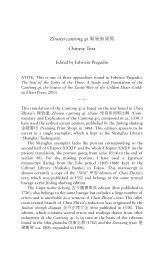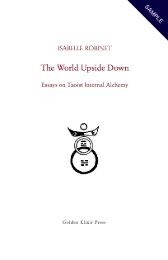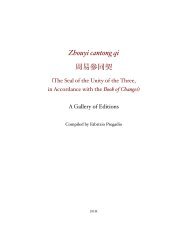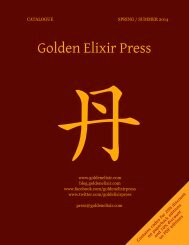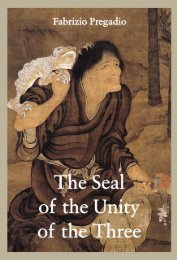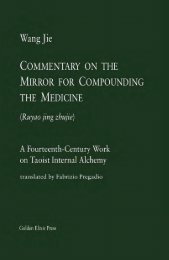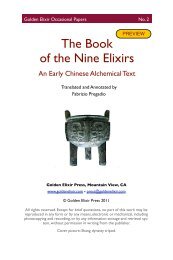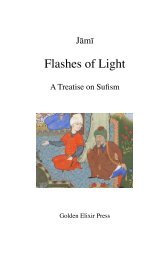The Seal of the Unity of the Three â Vol. 2 - The Golden Elixir
The Seal of the Unity of the Three â Vol. 2 - The Golden Elixir
The Seal of the Unity of the Three â Vol. 2 - The Golden Elixir
- No tags were found...
Create successful ePaper yourself
Turn your PDF publications into a flip-book with our unique Google optimized e-Paper software.
164 II. Commentaries, Essays, and Related Works<br />
—————————————————————————————————————————<br />
from Zhejiang) wrote his Fenshi guzhu Cantong qi (An Analytical<br />
Explication <strong>of</strong> Ancient Commentaries to <strong>the</strong> Cantong qi) in jail,<br />
where he was serving a sentence for uxoricide. A short colophon<br />
signed by Qintian Shuiyue 秦 田 水 月 tells that he had received <strong>the</strong><br />
Cantong qi on Mount Wuyi (Wuyi shan 武 夷 山 , Fujian) from a<br />
Nangdao zhe 囊 道 者 , also known as Qingteng shanren 青 藤 山 人 .<br />
Despite ten years <strong>of</strong> attempts, says <strong>the</strong> colophon, Qintian Shuiyue had<br />
not yet succeeded in ascertaining Nangdao zhe’s identity. Both characters<br />
in this account are Xu Wei’s alter egos, since <strong>the</strong>ir names are<br />
known as his pseudonyms. 13<br />
Except for <strong>the</strong> fanciful colophon, Xu Wei’s work does not bear a<br />
preface or a postface. His collected works, however, include an undated<br />
essay entitled “Preface to a Commentary to <strong>the</strong> Cantong qi” (“Zhu<br />
Cantong qi xu” 注 參 同 契 序 ). 14 In this essay, Xu Wei maintains that <strong>the</strong><br />
present Cantong qi contains not only Wei Boyang’s Canon, but also Xu<br />
Congshi 徐 從 事 ’s Commentary. He rejects, however, <strong>the</strong> arrangement<br />
<strong>of</strong> <strong>the</strong> Ancient Text, disputing <strong>the</strong> view that Canon and Commentary<br />
respectively consist <strong>of</strong> <strong>the</strong> portions in four- and five-character verses.<br />
According to Xu Wei, <strong>the</strong> portions that in most redactions <strong>of</strong> <strong>the</strong> Cantong<br />
qi correspond to Book 1 are Wei Boyang’s Canon; those that correspond<br />
to Book 2 are Xu Congshi’s Commentary; and those that correspond to<br />
Book 3 are equally divided between Canon and Commentary.<br />
On <strong>the</strong> basis <strong>of</strong> this understanding, Xu Wei Xu Wei divides <strong>the</strong><br />
Cantong qi into three Books, followed by a Postface (“Houxu”). Each<br />
section <strong>of</strong> <strong>the</strong> Canon is immediately followed by <strong>the</strong> corresponding<br />
section <strong>of</strong> <strong>the</strong> Commentary. <strong>The</strong> result <strong>of</strong> this rearrangement is<br />
actually similar to <strong>the</strong> version that Xu Wei criticized: <strong>the</strong> correspondences<br />
between <strong>the</strong> sections that he designates as Canon and Commentary<br />
<strong>of</strong>ten match those pointed out by commentators <strong>of</strong> <strong>the</strong><br />
Ancient Text. <strong>The</strong> main difference is that, in Xu Wei’s text, Canon<br />
and Commentary are not set apart from one ano<strong>the</strong>r according to<br />
13<br />
“Qintian Shuiyue” 秦 田 水 月 is a wordplay on Xu Wei’s name, created<br />
by reading <strong>the</strong> graph xu 徐 as formed by sanren 三 人 and he 禾 , and reassembling<br />
<strong>the</strong>se graphs into <strong>the</strong> graph qin 秦 ; and by breaking <strong>the</strong> graph wei 渭<br />
into its components tian 田 , shui 水 , and yue 月 . Xu Wei has a biography in<br />
Mingshi, 288.7387–88. See also Goodrich and Fang, eds., Dictionary <strong>of</strong> Ming<br />
Biography, 609–12, and Nienhauser, ed., Indiana Companion to Traditional<br />
Chinese Literature, 1:436–37. On his relation to Taoism, see Zhang Songhui,<br />
“Tan Xu Wei de daoshi shenfen ji qi yu Daojia Daojiao de guanxi.”<br />
14<br />
Xu Wei ji, 19.543–44. See also p. 186, note 6 below.<br />
© Fabrizio Pregadio and <strong>Golden</strong> <strong>Elixir</strong> Press 2012


